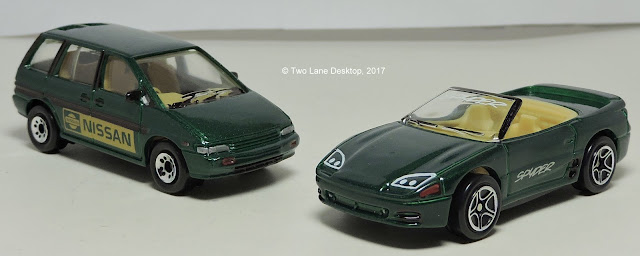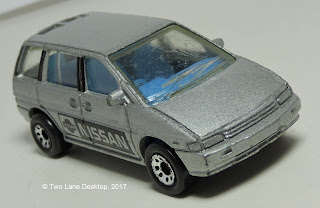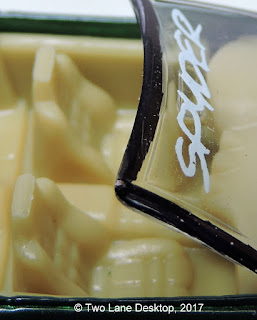Matchbox 1990 Nissan Prairie and Mitsubishi 3000GT VR4 Spyder
Matchbox cars from Japan automakers have seen limited success over the
years, sometimes coming in groups of waves with the first in the 1970’s and
1980’s. In the 1990’s even during the
Tyco-era there was a few unique castings from Japan that are still unique to
Matchbox today, and here’s a few in matching dark green with tan interiors: the
Nissan Prairie and the Mitsubishi 3000GT Spyder.
1990 Nissan Prairie
The Prairie was also known as the Axxess in the U.S. and was introduced in
1982 as a small MPV based on a car platform that was the first to use sliding
rear doors and flexible seating arrangement, even the front and rear doors
latched to each other since there was no B-pillar. In 1988 the Prairie was redesigned and lost
some of the unique touches like the reclining back seats due to the rear axle
going from torsion beam to coil springs and the B-pillar for better rigidity
and crash protection. The Axxess was
sold in the U.S. as a 1990 model due to a new minivan called the Quest released
in 1991. The styling of the
second-generation was smoother and slightly larger than before, while the
interior had seating for five with plenty of cargo space, visibility, and a
car-like dashboard layout. The engine is
a 2.4L DOHC I-4 that produced an estimated 150 horsepower through a 5-speed
manual transmission. The Prairie would
live on for another generation, but low sales would lead to an early demise of
the small MPV category.
One thing that I like about this casting is that Matchbox always kept the
casting clean of tampos no matter what design it had. I always enjoyed the silver with blue
interior and black Nissan logo on the doors since I was a kid and it was proper
to join with the dark green with tan interior and gold Nissan logo. The front has slim headlights that meet up
with the slim grille, lower bumper with lower grille and signal lights, and a
long hood with a sloping cab-forward look.
The sides show a typical wagon profile with sliding rear doors and large
window areas, while the 8-dot wheels look perfect on this casting and include a
working suspension with minimal wheel travel.
The rear has a narrow taillight bar with integrated signal and reverse
lamps and a black plate area that also serves as the base tab and caused
confusion when I added the taillight detailing (I thought the taillight bar was
taller, so after realizing the mistake I added black trim below the taillight bar.) The roof has two vent scoops just ahead of
the rear hatch opening, while the plastic base shows off the front-wheel
drivetrain, the fuel tank, and the exhaust system. The interior is very nicely done with front
bucket seats and a rear bench seat complete with ribbed pattern and headrests,
while up front the steering wheel is right-hand drive and very slim, the
dashboard nicely detailed, and the floor shifter is visible as well. A very nice utility wagon that is clean and
simple.
Mitsubishi 3000GT VR4 Spyder
On the other hand there’s a sportier car coming from Mitsubishi called the
3000GT and instead of doing the coupe Matchbox did the rare Spyder that was
converted by ASC. Called GTO in other
markets it was renamed in the U.S. to not cause confusion with the legendary
Pontiac of the same name, the car started life as HSX and HSR show cars in 1989
showcasing a sports coupe with technologically advanced features that included
a new DOHC V6, all-wheel drive, and four-wheel steering along with active
aerodynamics that were eliminated in the 1994 refresh. The 1994 refresh shows a new front-end with projector
headlights giving the car a spider look, new front bumper, and new
taillights. The interior is redesigned
with a driver-oriented dashboard layout that has center controls and auxiliary
gauges facing the driver and dual airbags.
The Spyder was only offered for 1995 and 1996 and featured a metal
hardtop that folded into the large rear trunk area, an amazing feat since this
was a hatchback coupe to start with. Not
only being the most powerful Japanese sports car to date it was also the first
to start the revitalization of the folding hardtop convertible, though sales
were limited to 877 units. The engine is
a twin-turbo 3.0L DOHC V6 that produces 320 horsepower and mated to a new
6-speed manual transmission to power the front wheels. Slow sales of Japanese sports cars of the
1990’s led to the 3000GT’s demise in 1999; the Dodge Steath, the Dodge version
of the 3000GT, lasted for only four years and was almost a Matchbox casting due
to join the Spyder but was cancelled at the last minute.
In 1995 there was a new Japanese Matchbox arrival: the Isuzu Rodeo/Vauxhall
Frontera, the Toyota Supra Turbo, and the Mitsubishi 3000GT Spyder. Problem is the first Spyders were adorned
with god-awful graphics, but by 1997 the graphics are replaced with front
headlight details and Spyder logo’s on the lower side rockers and windshield on
a yellow sports car with the new 5-spoke concave wheels. It now looks great! The car does sit lower and wider for a somewhat
awkward stance, yet it has all of the correct details to make you forget about
the stance issue. The front has the
detailed spider headlights, the hood blisters over the front wheels, and the
lower grille with integrated foglights and side gills. The sides have a smooth look with side scoops
ahead of the rear wheels and leads to the rear with the large trunklid and rear
spoiler, narrow taillight bar with integrated signal and reverse lamps, and
quad exhaust tips. The base shows off
the drivetrain with the all-wheel drive system, independent suspension, and
exhaust system that splits into a dual pipe arrangement after the rear axle and
no I have no idea what is behind the open holes over the center of the axles,
but it was short-lived for Matchbox.
The interior has some nice details that starts with four seats that have a
gridded pattern in them, the center console with shifter, the 4-spoke steering
wheel, and the dashboard that is separate from the interior piece to allow the
dashboard to curve toward the driver just like on the real vehicle. This casting, despite the fantastic details,
was always short on additional details like lighting so either with the
Premiere version with rubber tires or adding detailing yourself like I did it
improves the look of this casting, and just like the Prairie the 3000GT Spyder
is a unique casting that Matchbox still calls their own.
















































Comments
Post a Comment